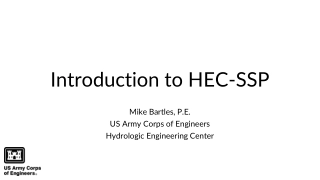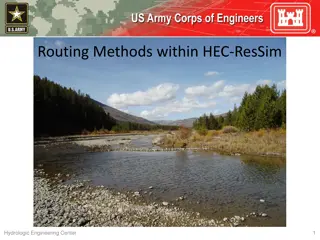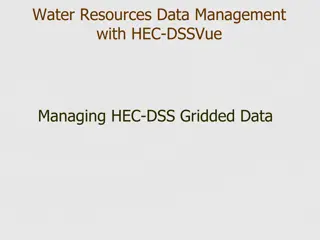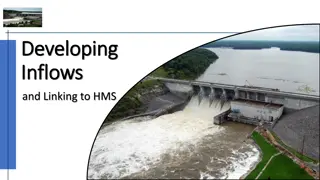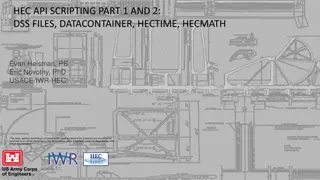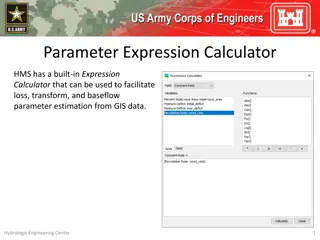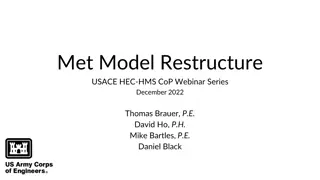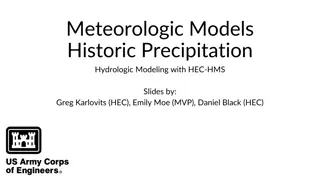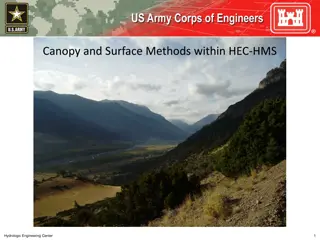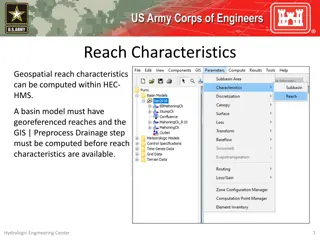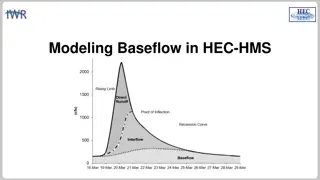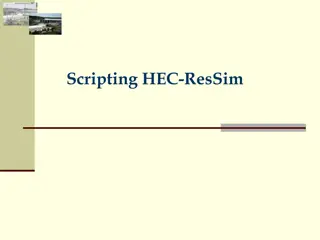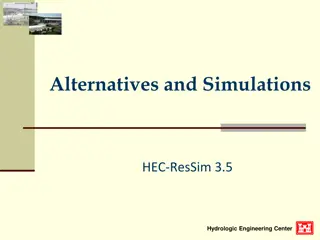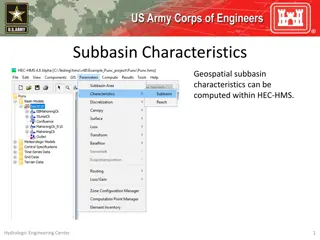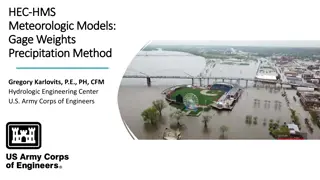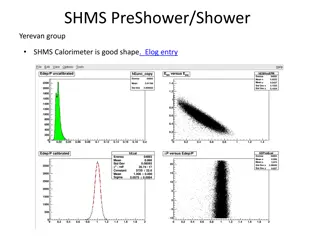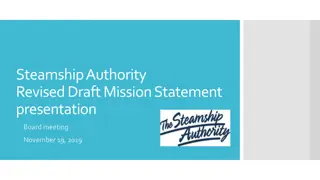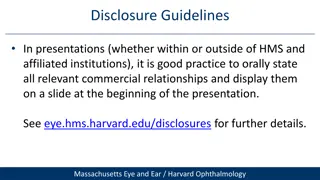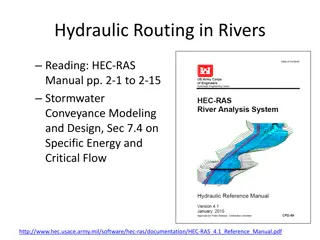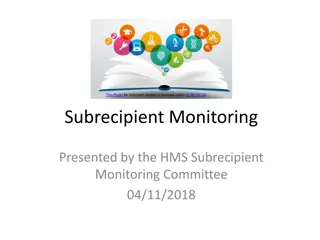Introduction to HEC-SSP
Explore the evolution and development of HEC-SSP, a software tool by the US Army Corps of Engineers, from its historical origins in the 1970s to its recent updates in analytical capabilities and user experience enhancements. Learn about the key team members behind the development and the new tools i
2 views • 52 slides
Hydrologic Modeling Methods in HEC-HMS: A Comprehensive Overview
Explore the transformative methods within HEC-HMS hydrologic modeling, including unit hydrograph derivation, excess precipitation transformation, hydrograph illustration, surface transform methods, and concepts like the kinematic wave and 2D diffusion wave. Learn about the unit hydrograph, kinematic
3 views • 41 slides
Introduction to Flood Risk Assessment with HEC-FDA Overview
This presentation delves into flood risk assessment using HEC-FDA software, covering topics such as defining flood risk, components of uncertainty, consequences of flood risk, and methods to assess flood risk including hydrology, hydraulics, geotechnical, and economics. It explores the intersection
7 views • 39 slides
Routing Methods in Hydrologic Engineering Center (HEC-ResSim)
Explore the differences between hydrologic and hydraulic routing, learn about open channel flow processes, and delve into channel routing within HEC-ResSim. Discover various reach routing methods, parameter estimation techniques, and calibration approaches. Dive into the Muskingum method and its app
8 views • 29 slides
Evolution of HEC-SSP Analytical Tools and Software Development Team
HEC-SSP, a software developed by the US Army Corps of Engineers, has evolved over the years to meet the statistical needs of the Corps. From its inception in FY2005 to the latest version, the software has seen significant enhancements in capabilities such as General Frequency, Curve Combination anal
9 views • 52 slides
Different Types of Scripts in HEC-ResSim
Explore the two main categories of scripts in HEC-ResSim - scripts executed outside simulations and scripts executed during simulations. Learn about the functions and properties of each type, including scripted rules and state variable scripts. Discover how these scripts compute flow limits, store m
7 views • 23 slides
Managing Water Resources Data with HEC-DSSVue
Learn about managing gridded data in HEC-DSSVue, including how grids represent spatial data, storing data in DSS, naming conventions, tools for manipulation, and more. Explore the importance of grids in hydrologic modeling and the application of spatial data in HEC-HMS and HEC-RAS.
5 views • 42 slides
Stochastic Storm Transposition in HEC-HMS: Modern Techniques and Applications
Explore the innovative methods and practical applications of Stochastic Storm Transposition (SST) in the context of HEC-HMS. Delve into the history, fundamentals, simulation procedures, and benefits of using SST for watershed-averaged precipitation frequency analysis. Learn about the non-parametric
3 views • 41 slides
GIS Data Management in Hydrologic Engineering Center (HEC) Software
Efficiently manage GIS data in HEC software by organizing background shapefiles, saving files in relevant directories, and utilizing relative pathnames. Understand the contents of basin files, GIS directories, and the step-by-step process involved in the delineation of elements within a project.
11 views • 5 slides
Reservoir Inflows and Computing Methods
Explore the methods for computing reservoir inflows, including mass balance formulas, known and unknown variables, and techniques to handle negative values. Learn about linking to HMS for hydrologic engineering, estimating local inflows, and utilizing smoothing techniques for accurate results.
1 views • 24 slides
Overview of HEC API Scripting Part 1 and 2: DSS Files, DataContainer, HecTime, HecMath
This report delves into the HEC API scripting involving DSS files, DataContainer, HecTime, and HecMath. It covers important classes, accessing files, and the distinction between DataContainers and HecMath objects. Additionally, it compares Python and Java, highlighting their differences in interpret
2 views • 28 slides
Hydrologic Modeling with Gridded Precipitation Data
Learn about utilizing gridded precipitation data for hydrologic modeling with HEC-HMS. Explore the advantages of spatially distributed precipitation sources such as RADAR and gauge comparisons, and understand the various national and regional products available. Discover utilities for converting and
3 views • 14 slides
Parameter Expression Calculator for Efficient Parameter Estimation from GIS Data
Parameter Expression Calculator within HEC-HMS offers a convenient tool to estimate loss, transform, and baseflow parameters using GIS data. It includes various options such as Deficit and Constant Loss, Green and Ampt Transform, Mod Clark Transform, Clark Transform, S-Graph, and Linear Reservoir. U
3 views • 5 slides
Restructuring of USACE HEC-HMS Meteorologic Model
Significant modifications have been made to the HEC-HMS meteorologic model to enhance modeling tasks' ease and intuitiveness. The Met Model Restructure updates in versions 4.9 to 4.11 streamline meteorologic processes, introduce new features like automatic linkages and zonal editors for snowmelt, an
0 views • 19 slides
Historic Precipitation Hydrologic Modeling with HEC-HMS Slides by Greg Karlovits, Emily Moe, Daniel Black
Delve into the world of hydrologic modeling with HEC-HMS through a detailed presentation by experts Greg Karlovits, Emily Moe, and Daniel Black. Explore meteorologic models, atmospheric boundary conditions, basin modeling, and simulation runs in this informative slide series.
1 views • 12 slides
Canopy and Surface Methods in HEC-HMS
Explore the various canopy and surface methods utilized in HEC-HMS for managing water resources. Learn about canopy interception, evapotranspiration, common parameter values, and factors affecting losses. Delve into available methods, canopy storage values, and surface depression storage. Enhance yo
0 views • 12 slides
Reach Characteristics in HEC-HMS Basin Modeling
Reach characteristics play a crucial role in hydrological modeling using HEC-HMS. Georeferenced reaches are essential for computing reach characteristics like slope, sinuosity, relief, and more. The process involves pre-processing drainage data before detailed reach characteristics can be obtained.
1 views • 5 slides
Baseflow Modeling in HEC-HMS
Baseflow in HEC-HMS plays a crucial role in modeling runoff volume, consisting of groundwater flow components like interflow and baseflow. Different approaches are used to model baseflow, with HEC-HMS currently incorporating conceptual methods. The response times for interflow and baseflow differ, i
2 views • 7 slides
Scripting in HEC-ResSim
Explore the two categories of scripts in HEC-ResSim - executed outside simulations and during simulations. Learn about static scripts for pre-processing, running simulations, and post-processing, along with the tools like Script Selector and Script Editor for script execution and editing.
0 views • 34 slides
HEC-ResSim Alternatives and Simulations Overview
Explore the functionalities of HEC-ResSim including creating, composing, and setting up alternatives for hydrological engineering simulations. Learn about ResSim alternatives, simulation modules, and the alternative editor in detail.
0 views • 31 slides
Subbasin Characteristics in HEC-HMS
Subbasin characteristics play a crucial role in hydrological modeling within HEC-HMS. Before computing these characteristics, the basin model must have georeferenced subbasins in the GIS. Various parameters such as basin slope, relief, elongation ratio, drainage density, and flowpath lengths and slo
0 views • 13 slides
Gage Weights and Precipitation Methods in Hydrologic Modeling
Exploring the concept of gage weights and precipitation methods in hydrologic modeling using the HEC-HMS software. Dive into the pros and cons of flexible gage weighting, calibration processes, and best practices for estimating time and depth weights. Discover how to set up a gage weights model, inc
1 views • 11 slides
The Colorado Health Insurance Buy-In Program
The Colorado Health Insurance Buy-In Program, presented by HMS, Inc., aims to improve health care equity, access, and outcomes for Coloradans while saving money on health care. By partnering with Health First Colorado, the program offers cost savings, wider provider networks, and coverage of medical
0 views • 15 slides
James Lind's Experiment on Scurvy Treatments: A Historical Analysis
James Lind's 1747 experiment on HMS Salisbury to test scurvy treatments is considered a significant milestone in biomedical science. Despite being a poorly designed study by modern standards, Lind's work paved the way for advancements in understanding and treating scurvy. This analysis delves into L
0 views • 15 slides
Updates on Calorimeter and Cherenkov Detectors in Yerevan Group's SHMS and HMS
Check out the latest updates on the calorimeter and Cherenkov detectors of Yerevan Group's SHMS and HMS. The SHMS detectors are in good shape, while adjustments in HV are needed for the HMS Cherenkov detectors to achieve optimal performance. Images and descriptions are provided in the Elog entries.
1 views • 6 slides
Evolutionary Journey of Charles Darwin
Discover the groundbreaking contributions of Charles Darwin to the theory of evolution through his voyage on the HMS Beagle, observations on the Galapagos Islands, study of finches and tortoises, and formulation of the theory of natural selection. His work revolutionized scientific understanding of
0 views • 30 slides
English Heritage: Images from Paul Berthelot's Estate
Discover a captivating collection of images showcasing English culture and architecture, acquired by Paul Berthelot during his time in the US Air Force stationed in England. From Battle Abbey in East Sussex to HMS Victory and The Mary Rose, immerse yourself in the rich history and beauty of these ic
1 views • 44 slides
Legacy of HMS Saumarez and HMS Skipjack in the Royal Navy's History
Dive into the historical significance of HMS Saumarez and HMS Skipjack, two notable vessels of the Royal Navy's Mediterranean Fleet during the Palestine Patrol. Discover their missions, armaments, crew details, and commanding officers through a collection of fascinating images and detailed descripti
0 views • 41 slides
Steamship Authority Revised Mission Statement Development Progress
The Steamship Authority is undergoing a revision of its mission statement, a process initiated by the HMS Consulting recommendations in 2018. The development of the new statement involves community input and values such as customer engagement, sustainability, reliability, safety, and efficiency. A P
0 views • 16 slides
Guidelines for Commercial Disclosure in Presentations
It is essential to disclose all relevant commercial relationships orally and visually at the beginning of presentations, whether within or outside Harvard Medical School and affiliated institutions. This includes stating any financial ties, research funding, consultancy roles, shareholdings, and boa
0 views • 4 slides
Research Cores Management System
HMS Research Core Facilities Project Vision aims to implement a common technology platform across 30+ HMS core facilities. The project seeks to standardize scheduling, ordering, pricing, and billing processes, integrating with Oracle's General Ledger for seamless journaling, billing, and payment col
0 views • 6 slides
Optimization Algorithm for Floodway Management
This research project delves into a novel floodway optimization algorithm for streams in Georgia, developed by Tien Yee and Huidae Cho from Kennesaw State University. The algorithm aims to streamline floodway modeling and management, offering insights into FEMA standards, typical criteria, tradition
0 views • 22 slides
Development of Sensitivity Analysis Application for HEC HMS Rainfall-Runoff Model
This content discusses the development of a sensitivity analysis application for an event-based HEC HMS rainfall-runoff model. It covers hydrological modeling, simulation options, Siron basin modeling, meteorological modeling, control specifications, and more.
0 views • 8 slides
Science Jeopardy
Explore the world of reproduction, heredity, and adaptations in this exciting science Jeopardy hosted by the HMS 7th Grade Science Teachers. From asexual to sexual reproduction, gene basics to phenotypes, and more, test your knowledge and learn about traits and genetic makeup through engaging questi
0 views • 27 slides
Automated Floodway Optimization for HEC-RAS
This research focuses on developing an automated floodway optimizer for HEC-RAS to determine the minimal area required to convey a 100-year flow without causing excessive flooding. The current manual process of finding encroachment limits is tedious and time-consuming. The proposed solution involves
0 views • 19 slides
Mastering Hydraulic Routing in Rivers: HEC-RAS Manual Insights
Dive deep into hydraulic routing in rivers with the HEC-RAS Manual, exploring topics like specific energy, critical flow, flood inundation, floodplain delineation, and steady flow solutions. Understand concepts such as flow conveyance, energy head loss, velocity coefficients, and solving steady flow
1 views • 12 slides
Evolutionary Insights from Malthus, Darwin, and Natural Selection
This historical introduction delves into the influential contributions of Thomas Malthus and Charles Darwin to the understanding of evolution through natural selection. It explores how Malthus' ideas on population dynamics and scarcity of resources, along with Darwin's observations during his journe
0 views • 36 slides
Subrecipient Monitoring Committee at HMS | Importance and Procedures
Explore the role of the Subrecipient Monitoring Committee at HMS, including membership details, subaward statistics, reasons for subrecipient monitoring, and the risk assessment database transition to GMAS. Learn about the significance of monitoring subrecipients and ensuring compliance with federal
0 views • 12 slides
Automate HMS Runs and Cumulus Grid Pull: Complete Guide
Learn how to completely automate HMS runs and major steps through scripts, automate Cumulus grid pull, create tokens, and build Cumulus scripts for data acquisition. Ensure efficiency by setting up tasks using Windows Task Scheduler for seamless automation.
0 views • 30 slides
HEC Strategic Vision and Implementation Plan
Discover how Hellenic Electronic Center (HEC) promotes Hellenic culture worldwide through strategic planning, online presence, and community engagement. Learn about their vision, mission, and purpose, along with key strategies for driving towards their goals and executing their initiatives effective
0 views • 10 slides
